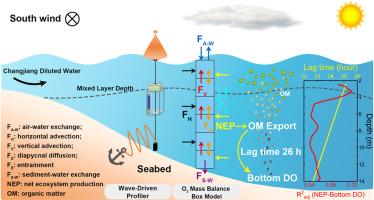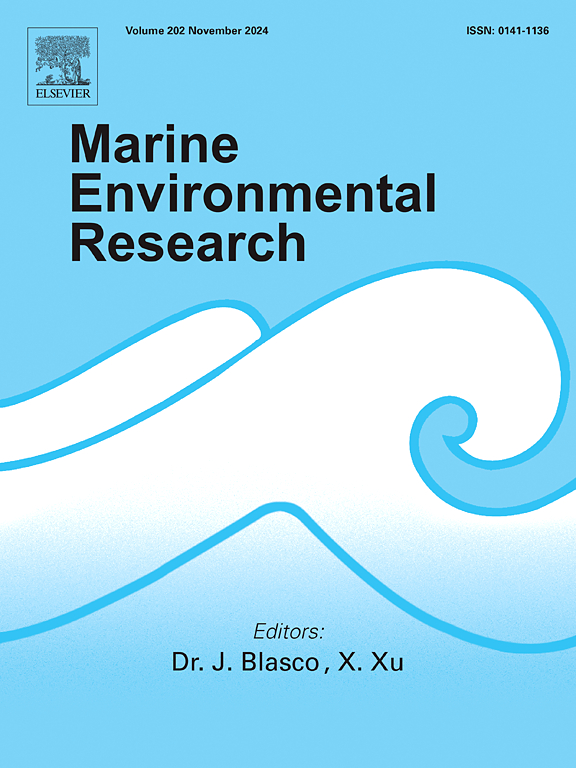Response of bottom dissolved oxygen reduction to net ecosystem production observed by a wave-driven profiler in the Changjiang River Plume
IF 3
3区 环境科学与生态学
Q2 ENVIRONMENTAL SCIENCES
引用次数: 0
Abstract
Coastal hypoxia, exacerbated by the combined influence of eutrophication and global warming, presents a significant environmental challenge. However, the lag correlation between organic matter (OM) export from the upper layers and bottom dissolved oxygen (DOBOT) reduction still lack clear elucidation. This study investigated the coupling between net ecosystem production (NEP, representing the maximum OM export) and DOBOT in the Changjiang River plume (CRP), using a wave-driven profiler system. The high-resolution profiles revealed rhythmic fluctuations in water column NEP, with sediment-water exchange (−74.6%) and NEP (−4.0%) dominating DOBOT reduction. Notably, surface NEP impacts DOBOT with a lag time of 25.65 h, indicating an OM sinking speed of 1.32 mm s−1. NEP at a depth of 3.4 m exerted the most significant influence on DOBOT, explaining a 12% reduction. These findings elucidate the response mechanism of DOBOT reduction to upper OM export and provide insights for hypoxia prediction in coastal and estuarine areas.

长江羽流中波浪驱动剖面仪观测到的底层溶解氧减少对生态系统净生产的响应
在富营养化和全球变暖的共同影响下,沿海缺氧现象日益严重,给环境带来了巨大挑战。然而,上层有机物(OM)输出与底层溶解氧(DOBOT)减少之间的滞后相关性仍然缺乏明确的解释。本研究利用波浪驱动的剖面仪系统研究了长江羽流(CRP)中生态系统净生产量(NEP,代表最大 OM 出口)与 DOBOT 之间的耦合关系。高分辨率剖面图显示了水体净生态生产量的节律性波动,沉积物-水交换(-74.6%)和净生态生产量(-4.0%)主导了 DOBOT 的减少。值得注意的是,表层 NEP 对 DOBOT 的影响滞后时间为 25.65 h,表明 OM 下沉速度为 1.32 mm s-1。深度为 3.4 米的 NEP 对 DOBOT 的影响最大,减少了 12%。这些发现阐明了 DOBOT 下降对上层 OM 出口的响应机制,为沿岸和河口地区的缺氧预测提供了启示。
本文章由计算机程序翻译,如有差异,请以英文原文为准。
求助全文
约1分钟内获得全文
求助全文
来源期刊

Marine environmental research
环境科学-毒理学
CiteScore
5.90
自引率
3.00%
发文量
217
审稿时长
46 days
期刊介绍:
Marine Environmental Research publishes original research papers on chemical, physical, and biological interactions in the oceans and coastal waters. The journal serves as a forum for new information on biology, chemistry, and toxicology and syntheses that advance understanding of marine environmental processes.
Submission of multidisciplinary studies is encouraged. Studies that utilize experimental approaches to clarify the roles of anthropogenic and natural causes of changes in marine ecosystems are especially welcome, as are those studies that represent new developments of a theoretical or conceptual aspect of marine science. All papers published in this journal are reviewed by qualified peers prior to acceptance and publication. Examples of topics considered to be appropriate for the journal include, but are not limited to, the following:
– The extent, persistence, and consequences of change and the recovery from such change in natural marine systems
– The biochemical, physiological, and ecological consequences of contaminants to marine organisms and ecosystems
– The biogeochemistry of naturally occurring and anthropogenic substances
– Models that describe and predict the above processes
– Monitoring studies, to the extent that their results provide new information on functional processes
– Methodological papers describing improved quantitative techniques for the marine sciences.
 求助内容:
求助内容: 应助结果提醒方式:
应助结果提醒方式:


